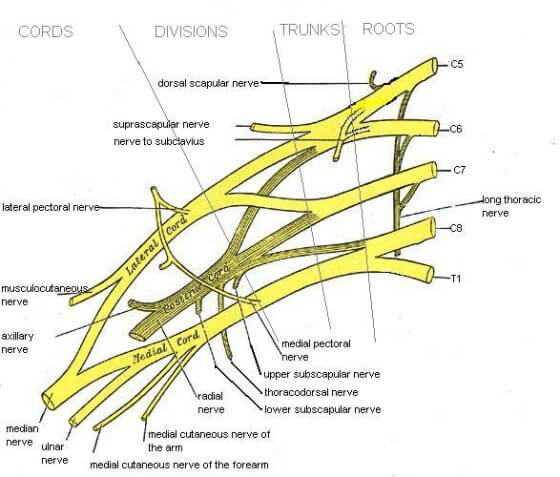According to statistics from the United Brachial Plexus Network, brachial plexus injuries occur in about two to five of every 1000 births. The symptoms can be severe and if left untreated, or misdiagnosed, this type of injury can lead to permanent damage and a lifetime of difficulties. For this reason, it is important to understand and recognize brachial plexus injuries in order to ensure timely and proper treatment, and a full recovery.
What is a Brachial Plexus Injury?
 The brachial plexus is a complex of nerves located in the shoulder and neck area that are responsible for sending signals to the shoulder, arm and hand from where the originate at the spinal cord. There are several types of injuries that can occur to the brachial plexus complex. The most severe type of brachial plexus injury is known as an avulsion, or severing, of the nerve root from the spinal cord itself. This type of serious injury will most likely require surgery and may lead to permanent debilitation. In less severe cases, an avulsion can be partial, in which case the nerve does have the potential to recover with proper treatment. In the least severe form of the injury, known as neuropraxia, the nerve is stretched rather than severed and recovery, though slow, is probable with treatment.
The brachial plexus is a complex of nerves located in the shoulder and neck area that are responsible for sending signals to the shoulder, arm and hand from where the originate at the spinal cord. There are several types of injuries that can occur to the brachial plexus complex. The most severe type of brachial plexus injury is known as an avulsion, or severing, of the nerve root from the spinal cord itself. This type of serious injury will most likely require surgery and may lead to permanent debilitation. In less severe cases, an avulsion can be partial, in which case the nerve does have the potential to recover with proper treatment. In the least severe form of the injury, known as neuropraxia, the nerve is stretched rather than severed and recovery, though slow, is probable with treatment.
Causes of Brachial Plexus Injuries
One of the most common causes of brachial plexus injuries is difficulty during birth, especially if the difficulty is due to a large baby or a breech birth. Under these conditions, an injury known as shoulder dystocia is more likely to occur. Shoulder dystocia can happen when the shoulder of the baby becomes stuck behind the pelvic bone of the mother. In this case, the physician or health care professional assisting with the delivery must use extra caution in order to avoid damaging the nerves of the brachial plexus of the infant. Though the risk of a having a brachial plexus injury when delivery by Caesarean section is greatly reduced, it does still happen.
Erb’s Palsy
Erb’s Palsy is a form of brachial plexus injury that can be extremely frightening to witness in a newborn baby. This injury is a serious condition and is apparent immediately after birth by witnessing a partial or complete paralysis of the arm. The damage can be permanent if the injury is severe, however, in many cases swift and appropriate treatment can improve the outcome for the newborn. Healthcare professionals should be aware of and understand appropriate protocols for difficult births and immediate treatment of newborns exhibiting signs of Erb’s palsy.
Brachial Plexus Injury Symptoms
Though it can be difficult to diagnose a brachial plexus injury that is not severe in a newborn, health professionals should be vigilant for symptoms, especially in the case of a difficult labor and birth. Usually, only one arm is affected by the injury, and depending on the location of the injury, the symptoms can vary. Often, the baby’s arm will be limp at the shoulder while the wrist and fingers are curled inward and do not open. This is caused by the root nerve damage at the spine. Newborns who suffer major brachial plexus injuries can experience severe pain and complete inability to move the arm or hand. Lesser damage can resolve, with treatment, in three to five months. Since an injury to the brachial plexus can lead to permanent damage, it is important to seek medical attention as soon as possible.
Brachial Plexus Treatment
It can’t be stressed enough that it is essential to diagnose and begin treatment as soon as possible after a brachial plexus injury to avoid permanent damage. This is especially true for newborns. Treatment of a brachial plexus injury includes physical therapy, and in infants who show no signs of improvement after three to five months, surgery may be recommended. Often, treatment includes immobilization of the arm and shoulder for a period of time, followed by physical therapy treatment to slowly introduce range of motion exercises. The most important component of treatment is to use a qualified health care professional with experience in treating injuries to the brachial plexus.
Effects of Erb’s Palsy and Brachial Plexus Injuries
While most cases of brachial plexus birth injuries, including Erb’s Palsy, respond well to treatment or surgery, for children in which brachial plexus injuries do not fully resolve, there can be lifelong problems. The ability to participate in sports may be hindered, and other activities of daily life may be difficult, such as driving. In turn, this can lead to a lower quality of life and low self-esteem.
If you think your newborn has suffered a brachial plexus injury as a result of birth trauma, or a medical error, it is important to understand the injury and your rights to compensation. Contact injury attorney Ivan Diamond today for a free consultation of your legal rights.

